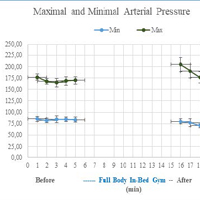To contrast and reverse skeletal muscle weakness by Full-Body In-Bed Gym in chronic COVID-19 pandemic syndrome

Accepted: 1 March 2021
HTML: 3
All claims expressed in this article are solely those of the authors and do not necessarily represent those of their affiliated organizations, or those of the publisher, the editors and the reviewers. Any product that may be evaluated in this article or claim that may be made by its manufacturer is not guaranteed or endorsed by the publisher.
Authors
Mobility-impaired persons, either very old or younger but suffering with systemic neuromuscular disorders or chronic organ failures, spend small amounts of time for daily physical activity, contributing to aggravate their poor mobility by resting muscle atrophy. Sooner or later the limitations to their mobility enforce them to bed and to more frequent hospitalizations. We include among these patients at risk those who are negative for the SARS-COV-2 infection, but suffering with COVID-19 pandemic syndrome. Beside managements of psychological symptoms, it is mandatory to offer to the last group physical rehabilitation approaches easy to learn and self-managed at home. Inspired by the proven capability to recover skeletal muscle contractility and strength by home-based volitional exercises and functional electrical stimulation, we suggest also for chronic COVID-19 pandemic syndrome a 10–20 min long daily routine of easy and safe physical exercises that can activate, and recover from weakness, the main 400 skeletal muscles used for every-day mobility activities. Persons can do many of them in bed (Full-Body in-Bed Gym), and hospitalized patients can learn this light training before leaving the hospital. It is, indeed, an extension of well-established cardiovascular-respiratory rehabilitation training performed after heavy surgical interventions. Blood pressure readings, monitored before and after daily routine, demonstrate a transient decrease in peripheral resistance due to increased blood flow of many muscles. Continued regularly, Full-Body in-Bed Gym may help maintaining independence of frail people, including those suffering with the COVID-19 pandemic syndrome.
How to Cite
PAGEPress has chosen to apply the Creative Commons Attribution NonCommercial 4.0 International License (CC BY-NC 4.0) to all manuscripts to be published.
Similar Articles
- Sandra Zampieri, Ines Bersch, Piera Smeriglio, Elena Barbieri, Simona Boncompagni, Maria Chiara Maccarone, Ugo Carraro, Program with last minute abstracts of the Padua Days on Muscle and Mobility Medicine, 27 February – 2 March, 2024 (2024Pdm3) , European Journal of Translational Myology: Vol. 34 No. 1 (2024)
- Barbara Ravara, Walter Giuriati, Maria Chiara Maccarone, Helmut Kern, Stefano Masiero, Ugo Carraro, Optimized progression of Full-Body In-Bed Gym workout: an educational case report , European Journal of Translational Myology: Vol. 33 No. 2 (2023)
- Sandra Zampieri, Ines Bersch, Piera Smeriglio, Elena Barbieri, Massimo Ganassi, Christiaan Leeuwenburg, Riccardo Rosati, Paolo Gargiulo, Amber Pond, H. Lee Sweeney, Ugo Carraro, Five Padua days on muscle and mobility medicine (2024Pdm3) 27 February - 2 March, 2024 at Hotel Petrarca, Thermae of Euganean Hills, Padua, and San Luca Hall, Prato della Valle, Padua, Italy , European Journal of Translational Myology: Vol. 33 No. 4 (2023)
You may also start an advanced similarity search for this article.

 https://doi.org/10.4081/ejtm.2021.9641
https://doi.org/10.4081/ejtm.2021.9641



